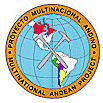| |
MAP Executive Council Meetings and PDAC (Activity: PM.98/M-6)
The next MAP Executive Council Meetings will be held in Toronto, Ontario, Canada during the week of the PDAC.
The meetings will be held at the Crown Plaza Hotel where the MAP Executive Council will also be staying. As agreed to in the last Executive Council Meetings in Buenos Aires, the meetings will be held over three days; March 13, 14, and 15. MAP will also have its own booth at the PDAC to present the MAP to the general public and display posters from each of the member countries.
MAP Executive Council Meetings
Agenda Items:
1) Metallogenic MAP
- Pricing
- Sales Distribution (Canada as supplier of maps, set up a corporation)
- Who holds the copyright?
(individual countries, GSC, corporation?)
- Use ISBN system? If so, do we need to barcode the map?
- Number of copies? It will affect pricing.2) Samples Database
" Technical Issues
- Report on Database Meeting held on March 13
- Final Distribution of Database
" Administrative Issues
- How will the software be maintained once MAP has concluded?
- Intellectual property rights
- Data distribution agreement between all countries?
3) Airborne Surveys
" Argentina / Chile Survey status report
" Bolivia / Chile / Peru Survey status report
4) Geochemical Reference Material
" Status Report
" ISO Certification of Samples?
5) MAP II
" Status of initial proposal
" Status of new members
" Time line
" What is the next step?
6) Work plans
" 2001/02 fiscal year:
" Argentina, Bolivia, Chile, Peru
Metallogenic MAP Meeting Agenda
For Geology Committee
" Map Presentation
a) Geology legend
b) Metallogenic/Line legend
c) Title d) Inset Maps
" Alternate inset map
" New colour for roads
" Subdued colours for geology
" Text for geology legend
" Right to publish topography on paper/digital from Military Geographic Institutes?
" Printer options a) map to be sold folded, flat or both?
" Data archiving
" Use ISBN system? If so, do we need to barcode the map?
" Timeline
" Compile recommendations to Executive Committee
MAPdb Meeting Agenda
" MAPdb presentation
- database structure
- layout contents
- data types included
- navigation
- reports
- special features (maps, plots, coord. transformation, colours, help docs.)
- data left to input
- data needed to complete
" Final MAPdb products
- full database, all data, with FileMaker Pro software -- to all countries (not for sale)
- runtime version, no data -- for free distribution via the web (3) read-only version with data, on CD -- for sale
" Training
- half-day workshop for users -- done in each countrys survey
- 1-day workshop for 2-3 scientists (maintainers) -- done in each countrys survey
" Maintenance
- Done by each country independently Possible: 1 update after 8 months (released 1 year after first release) including: debugging, revising, minor additions, merging new data from all countries.
EARTHQUAKE shakes up MAP Administration Office
Shaking and swaying of the building from a Magnitude 6.8 Earthquake was felt by all in the 16th floor Vancouver office of the Geological Survey of Canada at 10:55 AM (Pacific Standard Time) = 18:55 UTC on February 28, 2001. The Earthquake epicentre was located at 47.17 N Lat. / 122.73 W Long. in the United States of America about 250 km south of Vancouver, and 52.4 km deep in the crust, on a normal fault within the subducting Juan de Fuca plate. This is a similar tectonic setting to that along the coast of Chile and Peru, where even larger earthquakes have occurred in the past.
Almost everyone in Vancouver felt the earthquake, but there was very little damage (Intensity III - IV). The most destruction of property occurred in the Washington state capital of Olympia and in Seattle (up to Intensity IX). However, no one died as a result of the earthquake, and the damage was not as serious as it might have been, as most of the buildings are built to withstand earthquake shaking, and not to collapse. Teachers and school children in Washington and British Columbia have been trained in what to do in case of earthquake, and safe procedures were followed in all schools, so very few injuries occurred.
The Geological Survey of Canada played a major role in keeping the Canadian public informed about the earthquake through the website:
http://www.pgc.nrcan.gc.ca/seismo/table.htm and the news media. The GSC is also instrumental in disseminating information about what to do when an earthquake happens (or any other natural earth hazard, such as volcanic eruptions, landslides, and floods). At the GSC office, Emergency Preparedness measures were reviewed with all MAP and GSC staff in case of future earthquakes.
More information about the February 28 earthquake is available from the United States Geological Survey (USGS) at http://earthquake.usgs.gov/activity/latest/eq_01_02_28.html .
|

